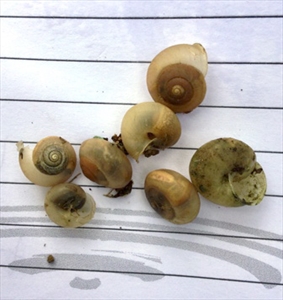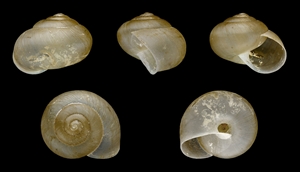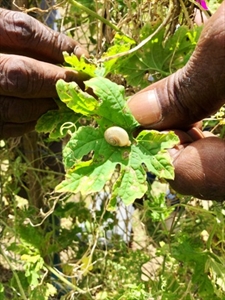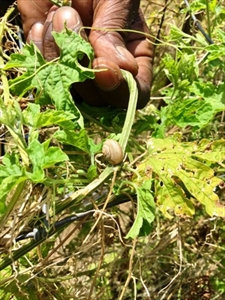- Worldwide distribution. Common in Pacific island countries.
- Shells vary, 12-16 mm diam, whitish to light brown, with or without narrow brown bands between whorls, and outward curved white lip. Hermaphrodite, capable of self-fertilization. Eggs below soil surface, hatchlings after 15 days, adults after 6 months.
- Damage direct: many crops (vegetables, trees, ornamentals) of economic importance eaten; indirect, faeces may contain rat lung worm.
- Spread on 'foot' or long distances via international plant trade.
- Biosecurity: commonly found on freight containers (hence the name 'tramp').
- Natural enemies: predatory snails and flatworms should NOT be introduced without environmental impact studies. These generalists will annihilate local snails. Use Indian runner ducks.
- Cultural control: bare earth or sand around plots; collect snails; use beer traps to attract snails.
- Chemical control: Note metaldehyde NOT encouraged: toxic to livestock, pets and humans; use baits with iron phosphate, sodium ferric EDTA - effective and safer.
Pacific Pests, Pathogens and Weeds - Online edition
Pacific Pests, Pathogens, Weeds & Pesticides
Asian tramp snail (369)
Asian tramp snail
Bradybaena similaris; previously, Helix similaris.
AUTHOR Grahame Jackson & Mani Mua
Information from Brodie G, Barker GM (2012) Bradybaena similaris (Rang, 1831). Family Bradybaenidae. Introduced land snails of the Fiji Islands. Fact Sheet Series, No. 2. USP, Fiji; and Bradybaenidae. Terrestrial Mollusc Tool. USDA, University of Florida. (http://idtools.org/id/mollusc/factsheet.php?name=Bradybaenidae); and Asian trampsnail. Wikipedia. (https://en.wikipedia.org/wiki/Asian_trampsnail); and from Capinera JL, White (2014) Featured Creatures: Terrestrial snails affecting plants in Florida. UF/IFAS, University of Florida. (http://entnemdept.ufl.edu/creatures/misc/gastro/terrestrial_snails.htm). Photo 1 Zell H Bradybaena similaris. (https://commons.wikimedia.org/wiki/File:Bradybaena_similaris_01.JPG).
Produced with support from the Australian Centre for International Agricultural Research under project HORT/2016/185: Responding to emerging pest and disease threats to horticulture in the Pacific islands, implemented by the University of Queensland and the Secretariat of the Pacific Community.







